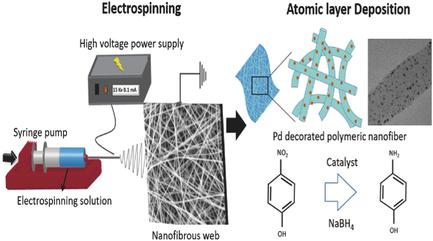当前位置:
X-MOL 学术
›
Adv. Mater. Interfaces
›
论文详情
Our official English website, www.x-mol.net, welcomes your feedback! (Note: you will need to create a separate account there.)
Monodispersed, Highly Interactive Facet (111)‐Oriented Pd Nanograins by ALD onto Free‐Standing and Flexible Electrospun Polymeric Nanofibrous Webs for Catalytic Application
Advanced Materials Interfaces ( IF 5.4 ) Pub Date : 2017-10-16 , DOI: 10.1002/admi.201700640 Kugalur Shanmugam Ranjith 1 , Asli Celebioglu 1 , Hamit Eren 1 , Necmi Biyikli 2 , Tamer Uyar 1
Advanced Materials Interfaces ( IF 5.4 ) Pub Date : 2017-10-16 , DOI: 10.1002/admi.201700640 Kugalur Shanmugam Ranjith 1 , Asli Celebioglu 1 , Hamit Eren 1 , Necmi Biyikli 2 , Tamer Uyar 1
Affiliation

|
An atomic layer deposition (ALD) of monodispersed palladium (Pd) nanograins (≈2 nm) onto electrospun polymeric nanofibers (NF) is presented. By ALD, monodispersed Pd nanograins with (111) exposed facets are decorated on the surface of the free‐standing flexible nanofibrous webs (NW). The Pd nanograin‐decorated free‐standing NW exhibit catalytic reduction of 4‐nitrophenol to 4‐aminophenol. Even under low loading capacity (≈20 µg mg−1), Pd nanograins manifest effective catalytic performance which can be referred to direct exposure of Pd single crystalline highly interactive (111) plains with high surface area on the NW. The Pd nanograins and the interactive sites along with the high surface area NW yield effective catalytic reduction of 4‐nitrophenol to 4‐aminophenol with the catalytic reduction rate of 0.0531 min−1. Pd nanograins display thermally tunable effective catalytic reduction properties with activation energy (Ea) of 1.705 J mol−1 on varying the reaction temperature from 12 to 42 °C. Moreover, Pd nanograin‐decorated NW are exhibited the effective reusable behavior with stable structural integrity even after repeated catalytic reactions. The approach of this study opens up synthesis and surface decoration of metal nanostructures onto NF through ALD with controlled size and facet orientation for designing reusable and free‐standing flexible catalytic nanofibrous materials.
中文翻译:

通过ALD将单分散,高度相互作用的面向小平面(111)的Pd纳米颗粒沉积到用于催化应用的自由和柔性电纺聚合物纳米纤维网上
提出了单分散钯(Pd)纳米颗粒(≈2nm)在电纺聚合物纳米纤维(NF)上的原子层沉积(ALD)。通过ALD,在具有独立性的柔性纳米纤维网(NW)的表面上装饰了具有(111)暴露面的单分散Pd纳米颗粒。钯纳米颗粒装饰的独立式净重表现出将4-硝基苯酚催化还原为4-氨基苯酚的能力。即使在低负载量下(≈20µg mg -1),Pd纳米颗粒表现出有效的催化性能,这可以称为NW上具有高表面积的Pd单晶高相互作用(111)平原的直接暴露。Pd纳米颗粒和相互作用的位点以及高表面积的NW可以将4-硝基苯酚有效催化还原为4-氨基苯酚,催化还原速率为0.0531 min -1。Pd纳米颗粒具有1.705 J mol -1的活化能(E a),具有热可调的有效催化还原性能。反应温度在12到42°C之间变化。此外,即使经过反复的催化反应,Pd纳米颗粒修饰的净重仍表现出有效的可重复使用行为和稳定的结构完整性。这项研究的方法通过控制尺寸和小面取向的ALD在NF上打开了金属纳米结构的合成和表面装饰,以设计可重复使用和独立式的柔性催化纳米纤维材料。
更新日期:2017-10-16
中文翻译:

通过ALD将单分散,高度相互作用的面向小平面(111)的Pd纳米颗粒沉积到用于催化应用的自由和柔性电纺聚合物纳米纤维网上
提出了单分散钯(Pd)纳米颗粒(≈2nm)在电纺聚合物纳米纤维(NF)上的原子层沉积(ALD)。通过ALD,在具有独立性的柔性纳米纤维网(NW)的表面上装饰了具有(111)暴露面的单分散Pd纳米颗粒。钯纳米颗粒装饰的独立式净重表现出将4-硝基苯酚催化还原为4-氨基苯酚的能力。即使在低负载量下(≈20µg mg -1),Pd纳米颗粒表现出有效的催化性能,这可以称为NW上具有高表面积的Pd单晶高相互作用(111)平原的直接暴露。Pd纳米颗粒和相互作用的位点以及高表面积的NW可以将4-硝基苯酚有效催化还原为4-氨基苯酚,催化还原速率为0.0531 min -1。Pd纳米颗粒具有1.705 J mol -1的活化能(E a),具有热可调的有效催化还原性能。反应温度在12到42°C之间变化。此外,即使经过反复的催化反应,Pd纳米颗粒修饰的净重仍表现出有效的可重复使用行为和稳定的结构完整性。这项研究的方法通过控制尺寸和小面取向的ALD在NF上打开了金属纳米结构的合成和表面装饰,以设计可重复使用和独立式的柔性催化纳米纤维材料。


























 京公网安备 11010802027423号
京公网安备 11010802027423号